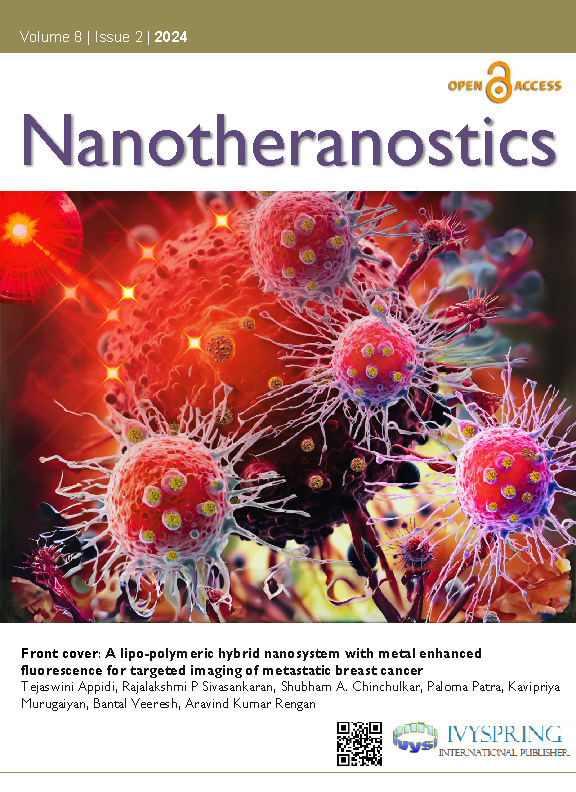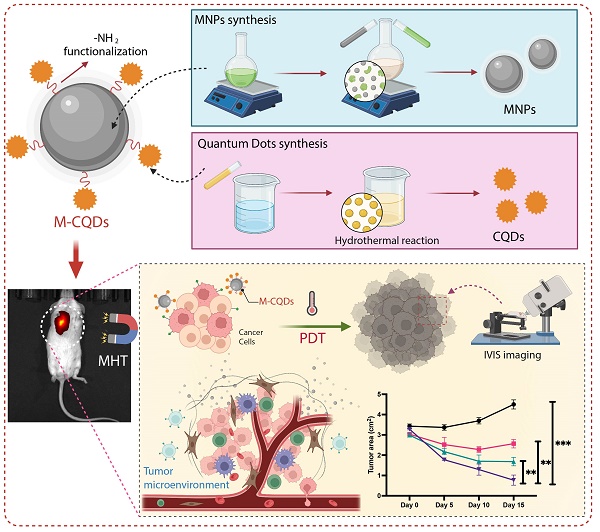ISSN: 2206-7418Nanotheranostics

Nanotheranostics, the sister journal of Theranostics, is a multidisciplinary and fully open access journal. Currently, the journal does not charge any publication or submission fees (Platinum open access). Nanotheranostics publishes innovative and original basic, translational and clinical research reflecting the fields of nanomedicine, nanoimaging, drug and gene delivery, nanoelectronic biosensors, and related areas.
Regular features include high quality research articles, reviews or mini-reviews, rapid communication of preliminary data on innovative research, editorials, and letters to the editor. Educational articles on basic sciences, fundamental aspects and controversy related to pre-clinical and clinical studies or ethical issues of nanomedicine are also welcome. Timely reviews that provide updates on current applications and issues in nanomedicine and translational aspects of nanotheranostics and other topics are particularly welcome and will be given high priority.
Nanotheranostics employs a rigorous peer-review system, but also strives for rapid review turnaround times and is based on the same streamlined submission platform as Theranostics.
Recent Papers:

Research Paper
Dual Functional Magnetic Nanoparticles Conjugated with Carbon Quantum Dots for Hyperthermia and Photodynamic Therapy for Cancer
Mounika Choppadandi, Kondi Soumya, Sumanta Ghosh, Aishwarya Balu, Tanvi Shingote, Srivalliputtur Sarath Babu, Vani Sai Prasanna, Somasundaram Arumugam, Ravichandiran Velyutham, Murali M. Yallapu, Govinda Kapusetti
Nanotheranostics 2024; 8(4): 442-457. doi:10.7150/ntno.91871
Abstract
Full text
PDF

Research Paper
Multimodal evaluation of blood-brain barrier opening in mice in response to low-intensity ultrasound and a claudin-5 binder
Liyu Chen, Jae Song, Gina Richter-Stretton, Wendy Lee, Pranesh Padmanabhan, Jürgen Götz
Nanotheranostics 2024; 8(4): 427-441. doi:10.7150/ntno.95146
Abstract
Full text
PDF

Review
Targeted Nanotheransotics: Integration of Preclinical MRI and CT in the Molecular Imaging and Therapy of Advanced Diseases
Jyoti Bonlawar, Aseem Setia, Ranadheer Reddy Challa, Bhaskar Vallamkonda, Abhishesh Kumar Mehata, Vaishali, Matte Kasi Viswanadh, Madaswamy S Muthu
Nanotheranostics 2024; 8(3): 401-426. doi:10.7150/ntno.95791
Abstract
Full text
PDF

Review
Knockout cancer by nano-delivered immunotherapy using perfusion-aided scaffold-based tumor-on-a-chip
Pooja Suryavanshi, Dhananjay Bodas
Nanotheranostics 2024; 8(3): 380-400. doi:10.7150/ntno.87818
Abstract
Full text
PDF

Review
Herbal Theranostics: Controlled, Targeted Delivery and Imaging of Herbal Molecules
Aseem Setia, Bhaskar Vallamkonda, Randheer Reddy Challa, Abhishesh Kumar Mehata, Paresh Badgujar, Madaswamy S. Muthu
Nanotheranostics 2024; 8(3): 344-379. doi:10.7150/ntno.94987
Abstract
Full text
PDF PubMed
PMC

Review
Characterizing morphological alterations in blood related disorders through Atomic Force Microscopy
Rohini Rakshak, Shweta Bhatt, Sushant Sharma, Rutesh Agharkar, Santosh Bodakhe, Rohit Srivastava
Nanotheranostics 2024; 8(3): 330-343. doi:10.7150/ntno.93206
Abstract
Full text
PDF PubMed
PMC

Research Paper
Biogenic Zinc Oxide Nanoparticles synthesized from Tinospora Cordifolia induce oxidative stress, mitochondrial damage and apoptosis in Colorectal Cancer
Hadgu Mendefro Berehu, Srinivas Patnaik
Nanotheranostics 2024; 8(3): 312-329. doi:10.7150/ntno.84995
Abstract
Full text
PDF PubMed
PMC

Research Paper
Adipose-derived stem cell exosomes act as delivery vehicles of microRNAs in a dog model of chronic hepatitis
Ilaria Zanolla, Martina Trentini, Elena Tiengo, Federica Zanotti, Tommaso Pusceddu, Andrea Rubini, Giuseppe Rubini, Francesca Brugnoli, Danilo Licastro, Marco Debortoli, Lucia Gemma Delogu, Letizia Ferroni, Luca Lovatti, Barbara Zavan
Nanotheranostics 2024; 8(3): 298-311. doi:10.7150/ntno.93064
Abstract
Full text
PDF PubMed
PMC
Editor-in-Chief:
Jonathan F. Lovell
SUNY Empire Innovation Professor
Department of Biomedical Engineering
University at Buffalo, State University of New York
Nanotheranostics has been selected by The Literature Selection Technical Review Committee (LSTRC) for inclusion in MEDLINE, the prestigious index of U.S. National Library of Medicine.
Nanotheranostics is now indexed in the Web of Science, Biological Abstracts and BIOSIS Previews.
- Full texts of articles in PubMed Central and Europe PMC. Abstracts in PubMed.
- (For NIH-funded researchers) Save time by submitting your paper to us - this journal is in full compliance with NIH Public Access Requirement.
Impact Score is 4.83, and h-Index is 25 based on information from Resurchify, 2023
CFP - Special Issue: Exploring the Frontier of Healthcare: Bioinspired and Biomimetic Nanotheranostics. Guest Editors: Drs. Murali M. Yallapu, Ajeet Kaushik, Kaushal Rege, Arpan Pradhan, Anuradha Kumari, Narendra Gupta.
CFP - Special Issue: Translational Nanomedicine and Biosensors. Guest Editors: Drs. Shweta Meena, Asifkhan Shanavas, Arvind K Rengan, Shabir Hassan, Berney Peng, Avtar Singh, Arnab Ghosh, Sunita.
Background: Combining magnetic particle imaging (MPI) and magnetic fluid hyperthermia (MFH) offers the ability to perform localized hyperthermia and magnetic particle imaging-assisted thermometry of hyperthermia treatment. This allows precise regional selective heating inside the body without invasive interventions. In current MPI-MFH platforms, separate systems are used, which require object transfer from one system to another. Here, we present the design, development and evaluation process for integrable MFH platforms, which extends a commercial MPI scanner with the functionality of MFH. Methods:....
Rationale: Microvascular obstruction (MVO) following percutaneous coronary intervention (PCI) is a common problem associated with adverse clinical outcomes. We are developing a novel treatment, termed sonoreperfusion (SRP), to restore microvascular patency. This entails using ultrasound-targeted microbubble cavitation (UTMC) of intravenously administered gas-filled lipid microbubbles (MBs) to dissolve obstructive microthrombi in the microvasculature. In our prior work, we used standard-sized lipid MBs. In the present study, to improve upon the efficiency and efficacy of SRP, we sought to determine....
In vitro metastatic models are foreseen to introduce a breakthrough in the field of preclinical screening of more functional small-molecule pharmaceuticals and biologics. To achieve this goal, the complexity of current in vitro systems requests an appropriate upgrade to approach the three-dimensional (3D) in vivo metastatic disease. Here, we explored the potential of our 3D β-tricalcium phosphate (β-TCP) model of neuroblastoma bone metastasis for drug toxicity assessment. Tailor-made scaffolds with interconnected channels were produced by combining 3D printing and slip casting method.....
